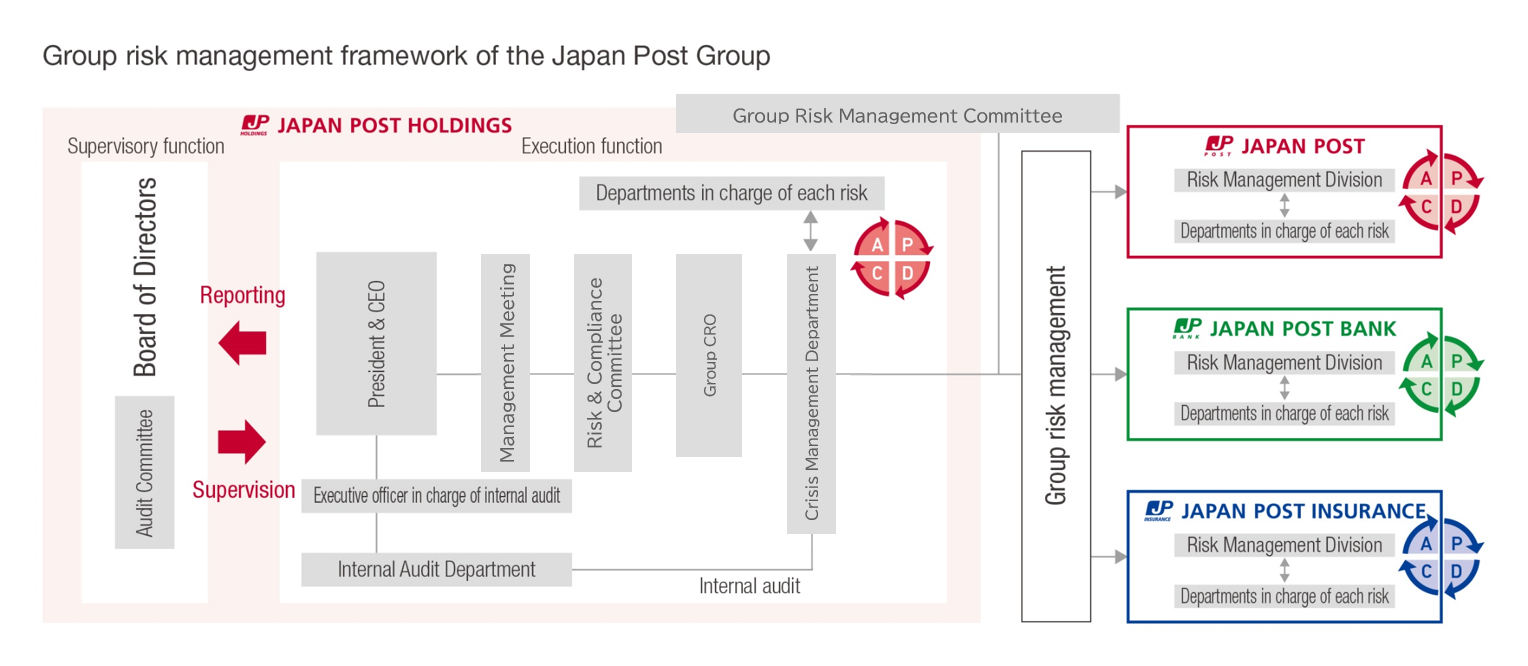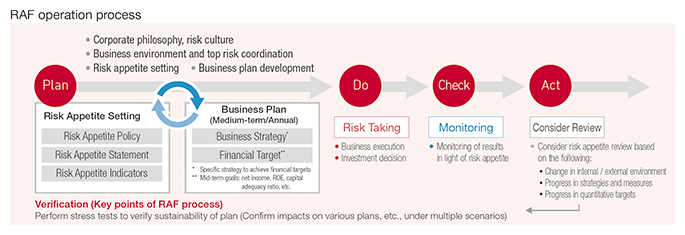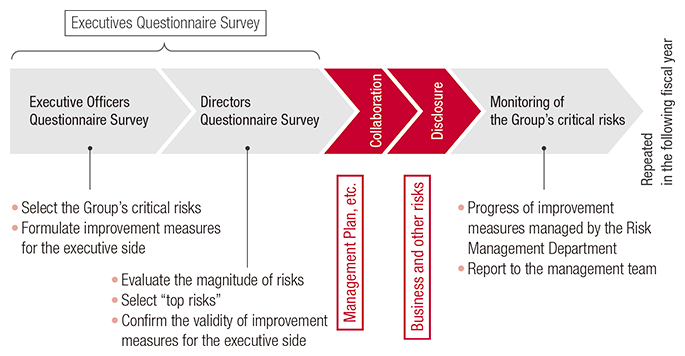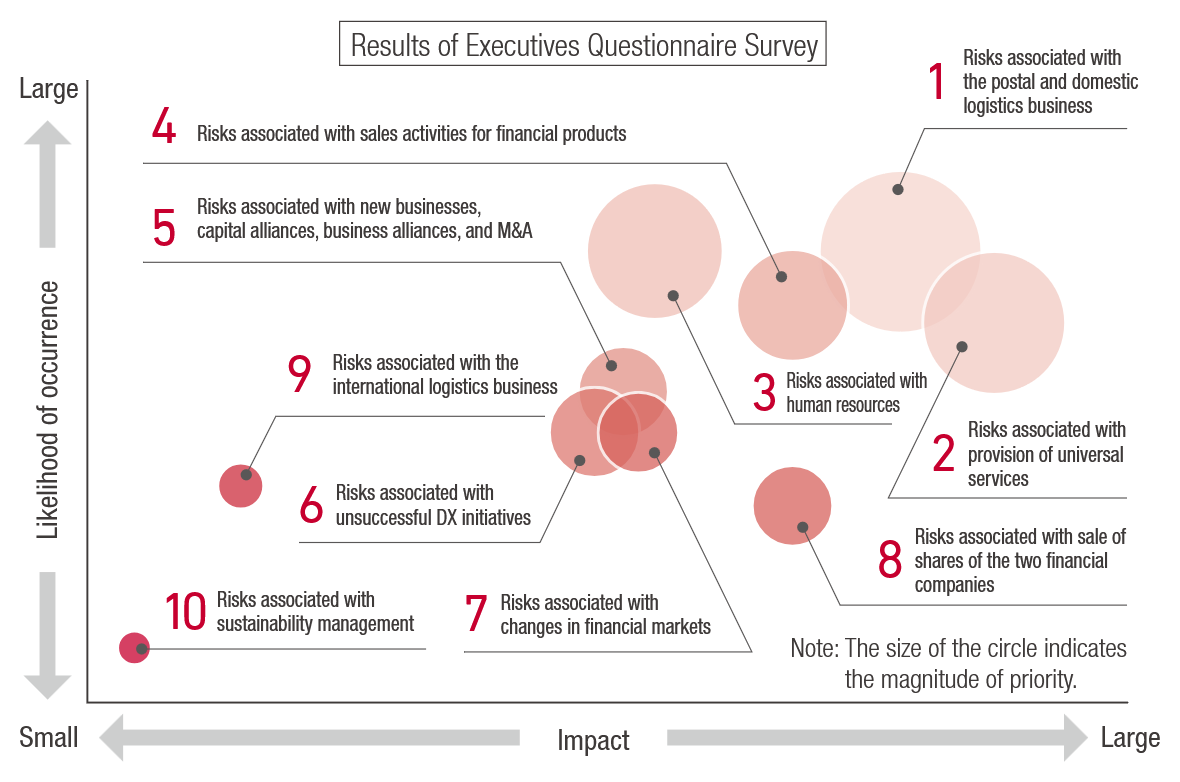- Position:
- Home

- English Home

- Investor Relations

- Management Policy

- Japan Post Group Risk Management
Japan Post Group Risk Management
In April 2024, the risk management function was integrated into the crisis management function and is now managed centrally by the Crisis Management Department, thereby promoting an aligned three-pronged approach of "crisis prevention," "early identification of risk manifestations," and "minimization of impact." As part of our risk management initiatives, we will strengthen controls over risks that could have a significant impact on the business of the Japan Post Group, including emerging risks, thereby establishing a system to prevent the materialization of risks that could have a major impact on the Group. We will also work to accelerate the reporting of risks to management when they arise.
In addition, by aligning the scope of control between risk management and crisis management, a smooth transition to crisis management, etc., can be achieved whenever risks materialize.
Furthermore, to strengthen Group governance, Japan Post Holdings appoints the Group Chief Risk Officer (CRO) from among its executive officers who reports to and is supervised by directors and others regarding the Group's risk management and its initiatives. In addition, the Group Risk Management Committee, which consists of executive officers in charge of risk management at each Group company, shares information and discusses risk management to improve the risk management of each Group company.
Furthermore, each Group company has designated a department to oversee its own risk management, and each department proactively identifies, assesses, controls, and monitors their risks in accordance with its own business characteristics, and has established a risk management framework where it reports necessary matters to Japan Post Holdings.
The Risk & Compliance Committee deliberates on matters regarding risk management and reports to the Management Meeting. In addition, the Management Meeting deliberates on important matters and requests deliberation by, or reports to, the Board of Directors.
Through these initiatives, we aim to ensure the sustainable and sound management of the Group.

Risk Appetite Framework (RAF)
The Japan Post Group has introduced its Risk Appetite Framework (RAF) from the fiscal year ended March 31, 2022, as a framework to control risks for the entire Group by clarifying the type and amount of risks (risk appetite) to be taken or accepted in order to expand earnings.
Utilizing this framework, the Japan Post Group will approve the risks and types of risks to be taken by its management together with the business plan, and aims to enhance corporate value by avoiding unexpected losses, improving the risk-return balance, and ensuring accountability.

Basic Concept for Risk Appetite by Business
Financial Businesses (Japan Post Bank and Japan Post Insurance)
We aim to secure profits while maintaining financial soundness through appropriate risk-taking and risk control in asset and liability management (ALM), investment operations, and insurance underwriting.
Non-Financial Businesses (Japan Post Holdings and Japan Post)
In the postal and domestic logistics business, real estate business, and new businesses, we will aim to secure new earnings while maintaining financial soundness through appropriate risk-taking and risk control within the scope of capital, excluding the financial and existing businesses.
Management of Critical Risks Facing the Group
Every year, Japan Post Holdings reviews risks that may have a significant impact on the Group's business (the Group's critical risks) based on such factors as changes in the external environment and business strategies. Japan Post Holdings identifies and evaluates specific risks by conducting a questionnaire survey of directors and executive officers (Executives Questionnaire Survey) and executes a PDCA cycle, through which the management team formulates improvement measures and monitors their implementation status, among other things.
The Group's critical risks are disclosed as "Business and Other Risks" in the Annual Securities Report.

Top Risks
Japan Post Holdings conducts a questionnaire survey of directors and other personnel to identify "risks to the Group's business and other activities that are of particular importance to management."
As a result, the Company evaluates the magnitude of risks from the perspective of likelihood of occurrence and severity of impact and designates the most significant risks as "top risks."
In collaboration with Group companies, Japan Post Holdings monitors the management status of top risks and improvement measures. The monitoring is incorporated into discussions for preventing risk manifestations, initiatives to minimize the impact on Group management, and to the formulation of the RAF and management plans.
Furthermore, the Company will define risks to be monitored from among risks that arise in its operations, etc., and promote the establishment of a system to manage such risks alongside top risks.
(Note) The business and other risks listed here are examples of major risks as of the date of publication of this report and are not limited to those listed here.
Please refer to the Annual Securities Report for details.

Top risks and main assumed scenarios for the fiscal year ending March 31, 2025 (Business and other risks of the Group that are of particular importance to the management of the Company)
| Top risks | Main assumed scenarios | |
| 1 | Risks associated with the postal and domestic logistics business | A decrease in mail volume due to the advance of digitization (including after setting postal rates commensurate with costs), weakness in revenues from parcels and other items due to intensified competition with other companies and the expansion of the e-commerce market, and the failure of initiatives to strengthen competitiveness at Japan Post thereby cause a significant decrease in the Group's earnings |
| 2 | Risks associated with provision of universal services | Initiatives to improve profitability and operational efficiency are not successful, and the cost burden for maintaining universal services increases due to inflation and other changes in the business environment. |
| 3 | Risks associated with human resources | Wage levels are inferior to those of other companies leading to an inability to retain talented human resources in various business roles as well as talent specializing in IT and other roles. In addition, an inability to provide a rewarding work environment due to the occurrence of personnel and labor issues lead to a loss or shortage of human resources and higher personnel costs compounded by a loss of competitiveness. |
| 4 | Risks associated with sales activities for financial products | With regard to insurance products and investment trusts handled by the Group, the development of new products and sales activities that take customer convenience into consideration are not successful and sales performance is slack, thereby causing a significant decrease in the Group's earnings. |
| 5 | Risks associated with new businesses, capital alliances, business alliances, and M&A | An inability to realize its growth strategy through new businesses, inability to obtain benefits from capital and business alliances, etc., and impairment losses related to investment businesses cause a significant decrease in the Group's earnings. |
| 6 | Risks associated with unsuccessful DX initiatives | If the Group's integrated DX measures are not successful or if the Group is unable to respond appropriately to changes in the business environment, its competitiveness will decline. |
| 7 | Risks associated with changes in financial markets | Sharp market fluctuations cause the business of the two financial companies to deteriorate, and the value of their holdings will fall sharply. In addition, rising interest rates lead to the reallocation of fixed savings and other deposits and the cancellation of insurance policies |
| 8 | Risks associated with sale of shares of the two financial companies | Factors such as losses from the sale of shares of the two financial companies, an inability to secure alternative revenue sources replacing the two financial companies, and/or the difficulty of conducting integrated, Group-wide business operations as a result of a declining equity stake in the subsidiaries lead to customer attrition and a weakening of brand power and thereby cause a significant decrease in the Group's earnings. |
| 9 | Risks associated with the international logistics business | Toll Holdings' business model and growth strategy for its international logistics business is not successful, and a slowdown in the global economy, heightened geopolitical risks, and other factors leading to business performance stagnation owing to the deteriorating business environment thereby cause a significant decrease in the Group's earnings. |
| 10 | Risks associated with sustainability management | The Group loses the support of its stakeholders due to insufficient progress: its initiatives to address key sustainability issues. |



